Anti-aircraft missile systems on submarines: the inevitable evolution of the submarine
To begin with, we will announce a few points:
1. Submarines (submarines), in particular nuclear submarines (submarines), are the main striking force of the Naval fleet (Navy) of Russia.
2. In fact, at the moment, submarines are the only means of the Russian Navy that pose a threat to the naval forces (Navy) of potential adversaries at a distance from their own shores.
3. Detection and destruction of our submarines can be carried out:
- submarines and submarines of the enemy;
- enemy surface ships (NK);
- planes and helicopters aviation anti-submarine defense (PLO) of the enemy.
4. Our submarines can actively counter enemy submarines, submarines and NKs.
Note. Serious qualitative and quantitative problems with the equipment and weapons of Russian submarines / submarines are periodically voiced on the pages of VO. In particular, with torpedo armament and anti-torpedoes (they are either outdated or not worked out, or they are few or not available at all). In this article, we put this question out of the brackets. Since at least work is underway in this direction, and claims to their current results are publicly voiced.
5. Our submarines are incapable of counteracting the PLO aviation (for the sake of fairness it must be said that no submarines can do this yet). They can only hide from them.
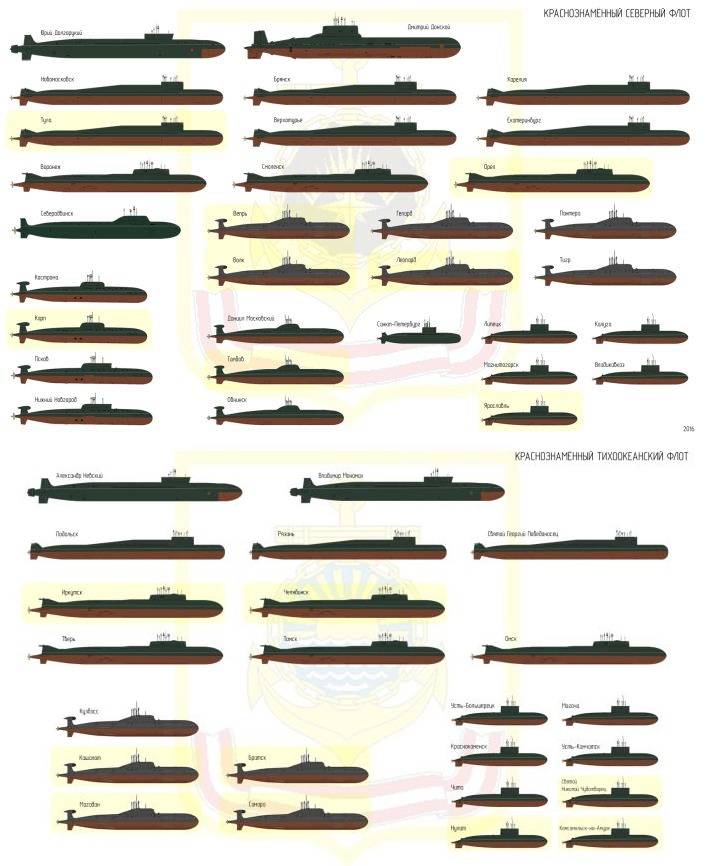
Submarines are the main striking force of the Russian Navy
What poses the greatest threat to SPs?
The threat to submarines consists of the possibility of its detection and the probability of its destruction.
A submarine-hunter, performing the task of detecting enemy submarines, cannot move faster than the low-noise speed, which for the most modern submarines is about 20 knots, that is, about 40 km / h. At higher speed, the PLA-hunter will unmask himself with noise and will turn into a target itself. Comparable figures can be used for surface ships.
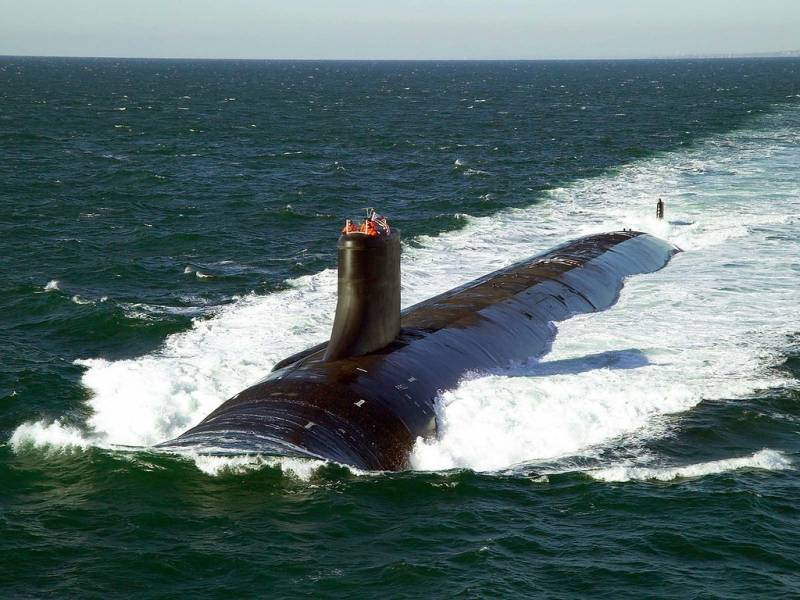
American submarines Seawolf have a low-noise speed of 20 knots and are one of the most dangerous underwater opponents.
The detection range of submarines by an enemy submarine or surface ship depends on the technical level of the ships of the opposing sides, the experience of the crews and the hydrological situation in the search area.
Based on open sources, it can be assumed that the detection range of submarines can be about 50 kilometers or less.
The next factor is the range of weapons used to defeat submarines. The range of the American Mk-48 torpedo reaches 50 kilometers, the RUM-139 VL-Asroc missile-torpedoes used from surface ships have a range of 28 kilometers, plus 10 kilometers of the cruising range of the Mk-54 torpedoes installed on them.
For simplicity, we will take a single defeat range - 50 kilometers.
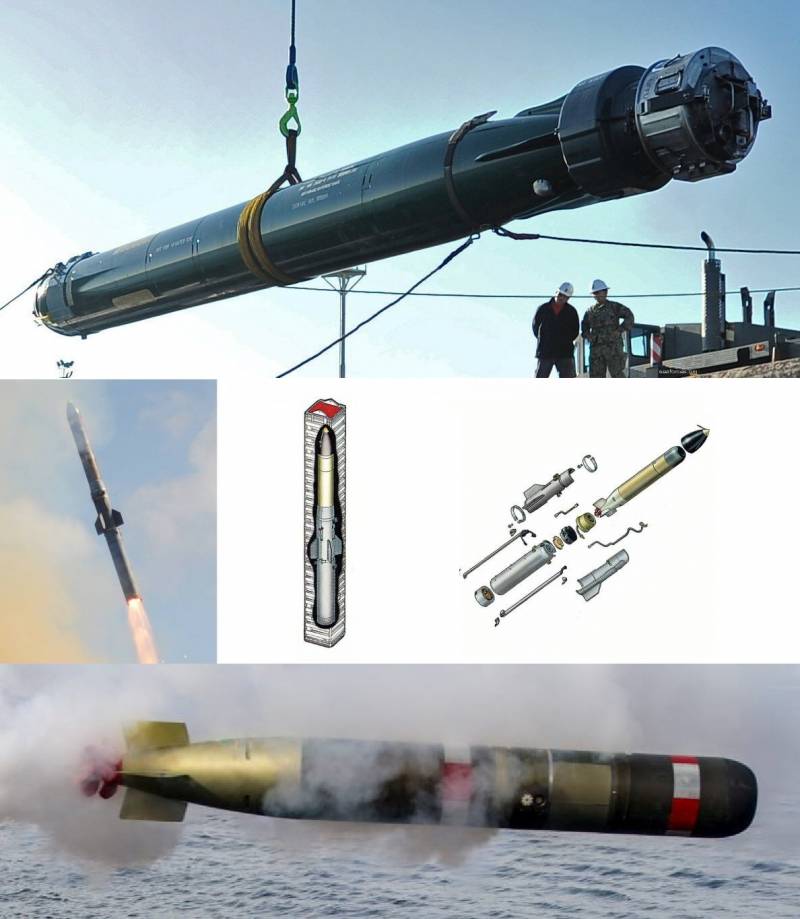
Torpedo Mk-48 (top) and rocket-torpedo RUM-139 VL-Asroc (bottom) - launch, diagram and delivered small torpedo. Pay attention to how much space a torpedo takes in a rocket-torpedo - it will not be possible to increase its range significantly.
Thus, a ship or submarine can travel about 1000 kilometers per day, having surveyed 100 square kilometers, in which they can potentially detect and destroy enemy submarines.
It is a square with a side just over 300 kilometers.
Is it a lot or a little, given that the actual surveyed area will be much smaller due to the need to "search" for potential contacts?
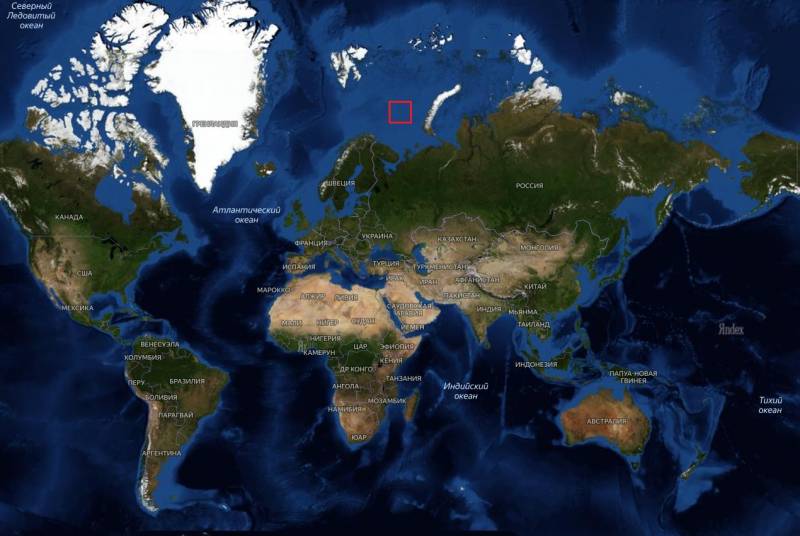
The approximate area that a submarine or surface ship can survey for the presence of an enemy submarine per day.
Of course, you could say that this is not how the search works. And that the surface ship will not snake along the route. That will involve carrier-based aircraft and sonar buoys.
But we need to understand how critical the impact of the presence / absence of aviation on the anti-submarine capabilities of the fleet is. Therefore, at this stage, aviation in any form is deliberately excluded.
Although sonar buoys will simplify the search, they will in no way solve the problem of hitting submarines outside the zone of action of anti-submarine weapons. Their number on the ship is limited, and deployment will also take time.
Of the above figures, the limited range of anti-submarine weapons... It is unlikely that it can be significantly increased in any way. In the absence of aircraft, the enemy's NK or submarine cannot in any way hit a detected submarine that is outside the range of torpedoes / rocket-torpedoes. By the time a submarine or NK reaches the line of attack, contact with the detected submarine may have already been lost.
In addition, the attacked submarine can detect its pursuers, dodge torpedoes, deceive them with decoy targets or intercept them with counter-torpedoes, and also attack itself. The situation may well develop so that the enemy's anti-submarine forces will be detected and attacked before they can detect the desired submarine.
PLO aviation has a huge advantage - a high flight speed, which is more than an order of magnitude higher than the speed of movement of NK and submarines. This allows her to quickly move to a given area, to concentrate the necessary forces in a selected area. Anti-submarine aviation is capable of both acting independently and acting as a "catalyst" for the anti-submarine effectiveness of surface ships.
The second important advantage of ASW aviation is its actual invulnerability to submarines at the moment.
NATO's ASW aircraft includes hundreds of anti-submarine aircraft and helicopters. And how are the crews of the planes and helicopters of the PLO of the potential enemy feeling now?
And they feel great.
At present, there are practically no threats to them. We have no deck aviation. And it is unlikely that it will appear in the near future. It is enough to stay away from surface ships. In general, you can work calmly, drinking coffee from a thermos, consistently searching for and destroying Russian submarines.
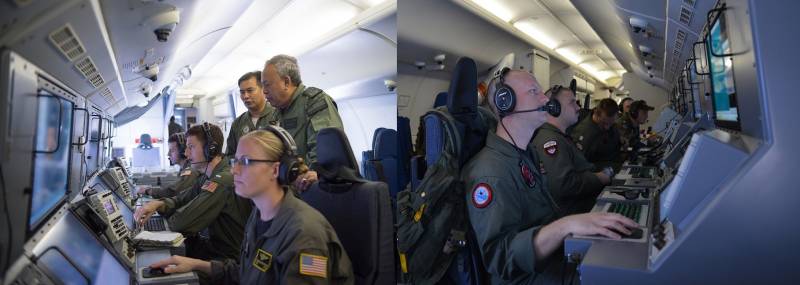
The crews of PLO aircraft and helicopters can work in a calm, comfortable atmosphere, because they are not in danger now.
However, let's imagine that anti-aircraft missile systems (SAM) appeared on submarines.
Features of the confrontation
It is believed that air defense (AA) based only on air defense systems, without the support of fighter aircraft, will always lose the battle of attacking enemy aircraft.
This is due to the highest mobility of the latter, which allows each time to concentrate the forces necessary to "hack" a specific air defense area, then move on to the next, and so on.
Let's assume (conditionally) that our air defense systems have become "underground", and their exact location is unknown. At the initial stage, in general, there is no information whether they are in a particular area or not. Only a few minutes pass between their appearance “on the surface” (deployment), and after a few minutes they disappear again, after which their location begins to change at a speed of the order of 10–40 km / h (the quiet speed of submarines of different types). The attacking aviation will neither work out a safe route for the passage, nor throw anti-radar missiles or stealthy gliding bombs on the air defense system.
How much would the losses of the USA / NATO have increased if such "wandering" air defense systems appeared in Iraq or Yugoslavia?
Now let's get back to PLO aviation.
Unlike land, the situation here is much worse. In combat mode, PLO aircraft and helicopters are limited in the choice of the altitude profile and flight speed.
For example, the American P-8 Poseidon anti-submarine aircraft patrols at an altitude of 60 meters and a speed of 333 km / h. For any modern air defense system, this is just a gift. No supersonic low-altitude breakthroughs using uneven terrain, no high-altitude flights at 15-20 kilometers and a speed of 2-3M.
PLO aviation is a rather expensive toy.
If at least piston / turboprop aircraft can be used on land - modern analogues of aircraft of the Second World War (for solving a number of problems), then this will not work with countering submarines.
Nor will it be possible to make many inexpensive unmanned aerial vehicles (UAVs) to solve PLO problems. They will have to carry sophisticated search equipment and heavy torpedoes. "Baykatars" are not enough here.
In general, the loss of PLO aircraft and helicopters financially will always be very sensitive for the enemy.

The anti-submarine capabilities of the Northrop Grumman MQ-4C Triton UAV are very limited, and the price is comparable to the cost of the latest P-8 Poseidon PLO aircraft.
Psychological factor.
As we mentioned earlier, the crews of PLO aircraft and helicopters are now working in comfort. But what if the situation has changed and the threat of a surprise attack looms over them? The pilot of a combat aircraft can eject, on the ground, he can try to get out on his own or wait for a rescue team. He can get drinking water, food, find shelter.
It will be much more difficult to do all this on the high seas. This is not to mention the fact that the 9 crew members of the P-8 Poseidon, shot down at an altitude of 60 meters, have practically no chance of escape. The crews of the PLO helicopters do not have them either.
And if anyone survives? In a life jacket, in cold waters or warm, but with sharks by your side?
If the PLO helicopter can be close to the carrier, then PLO aircraft fly far away.
It is almost impossible to pick them up from the water - the helicopter will not have enough range. And from airplanes only amphibians can do it. But the US doesn't have them. And they can not sit down with any excitement. It takes a long time for the ship to go. And will he be sent in a combat situation for the possible rescue of several people?
In general, in such a situation, hunting submarines will no longer be an easy walk. Which will accordingly affect the mood of the crews. It is possible that some of them will no longer want to know

The presence of air defense systems on Russian submarines will make the work of the crews of US and NATO PLO aircraft and helicopters much less comfortable.
Why not shoot down PLO planes and helicopters using surface-to-air missile systems?
Yes, because a surface ship, or a naval strike group (KUG) is the same "ground" air defense outpost, on which, when it is detected, the number of aircraft, anti-radar and anti-ship missiles (ASM) necessary for its destruction will be thrown.
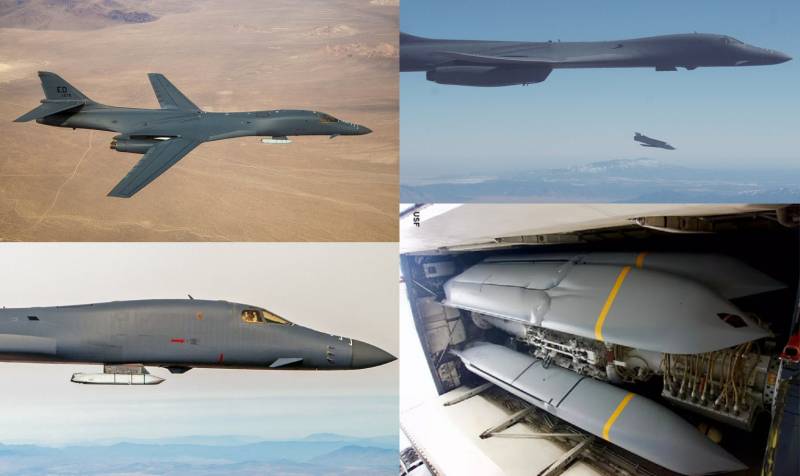
The B-1B bomber will be able to carry up to 36 AGM-158C LRASM anti-ship missiles on the external sling and in the internal compartments. Ten B-1B aircraft can launch a flock of 360 stealth low-flying anti-ship missiles, which cannot be repelled by any air defense.
Another important factor is that land-based air defense systems or air defense systems of surface ships most often have to protect not only themselves, but also some other objects: cover an oil refinery or armored vehicles, a landing ship or a supply vessel. The submarine does not need to cover anyone; it is enough for it to fight off the attacking planes or PLO helicopters. In addition, air defense systems on submarines can be used as an offensive weapon.
Technical solutions
The very idea of equipping submarines with air defense systems is not new. In particular, the French Navy conducted active research in this direction.
In early 2018, the author published an article Atomic Multifunctional Submarine Cruiser: Asymmetrical Response to the West and its continuation - Atomic Multifunctional Submarine Cruiser: Paradigm Shift.
In these articles, the issue of creating a nuclear multifunctional submarine cruiser (AMFPK) equipped with cruise missiles and long-range air defense systems was considered. The second article provides examples of foreign projects of underwater air defense systems. The complexity of implementation and the tasks that AMPPK can solve are a topic for a separate conversation. Better to start with something simpler.
The use of air defense systems on submarines, coupled with other active defense systems, was also considered by the author in the article At the border of two environments. The evolution of promising submarines in conditions of increased probability of their detection by the enemy.
Why is the air defense system on the submarine still not implemented, because the United States is quite capable of this task?
It can be assumed that during the confrontation between the United States and the USSR, when there was a need for this, technical obstacles did not allow this - there were no effective infrared and active radar homing heads (IR seeker / ARL seeker), which would allow the destruction of targets without their continuous support by the carrier. And now the United States simply does not need it, since Russia has practically no anti-submarine aviation, and the Chinese has not yet reached the required technical level.
Nevertheless, according to some reports, the United States is considering the possibility of installing a 300-500 kilowatt laser weapon on a Virginia-class submarine. The advantages of this solution were considered by the author in the article At the border of two environments. Why is the US Navy a combat laser for a Virginia-type nuclear submarine and is Peresvet needed for a Laika project nuclear submarine?
In short, laser weapons provide significantly higher concealment of use than air defense systems. The output optics of the laser can be placed on the periscope, during its operation there is no noise and vibration, there are no sounds of opening mines, launching missiles.
In the case of using an optical location station (OLS) for guidance, the crew of an airplane or an PLO helicopter may not even understand that it was attacked (laser radiation sensors may not detect damage to some points). However, with all the promise of laser weapons, we should focus on more realistic projects. We do not yet have solid-state lasers with a power of 300–500 kW.
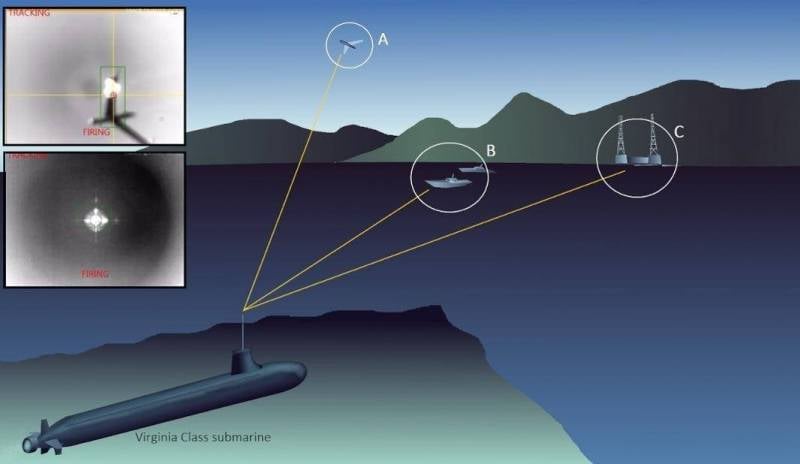
Perhaps the Virginia-class submarines will become the first submarines capable of destroying ASW aircraft from under the water, while at periscope depth.
One of the main problems of the Russian Navy is significant delays in the introduction of new technologies. Therefore, at the first stage of the introduction of air defense systems on submarines, it is necessary to apply the simplest and most economical technical solutions.
Based on this, it can be assumed that the optimal solution for the cost / efficiency criterion may be the integration of the Redut-type air defense missile system on the submarine. Of course, the complex will undergo some changes. First of all, in terms of target detection and target designation to anti-aircraft guided missiles (SAM). This task should be solved by means of a regular submarine periscope.
Of course, a radar station (radar) is capable of significantly increasing the capabilities of an air defense system. But the existing solutions are large enough. And if we are not talking about a specialized submarine, like the aforementioned AMFPK, then it will be difficult to integrate the radar on a multipurpose submarine. In the future, of course, there will be comfortable solutions that do not increase the dimensions of the periscope tip.
To defeat planes and helicopters of PLO aviation, upgraded 9M96E, 9M96E2 missiles with an active radar homing head (ARLGSN) and 9M100 short-range missiles with an infrared homing head (IKGSN), capable of engaging targets without continuous target designation or target illumination, should be used.
Of course, with this method of target designation, the probability of a miss increases, but after all, our target is not a super-maneuverable fighter, not a hypersonic warhead, not an inconspicuous cruise missile or even a U-2 high-altitude reconnaissance aircraft, but a large-sized, non-maneuverable, slowly flying plane or a PLO helicopter.
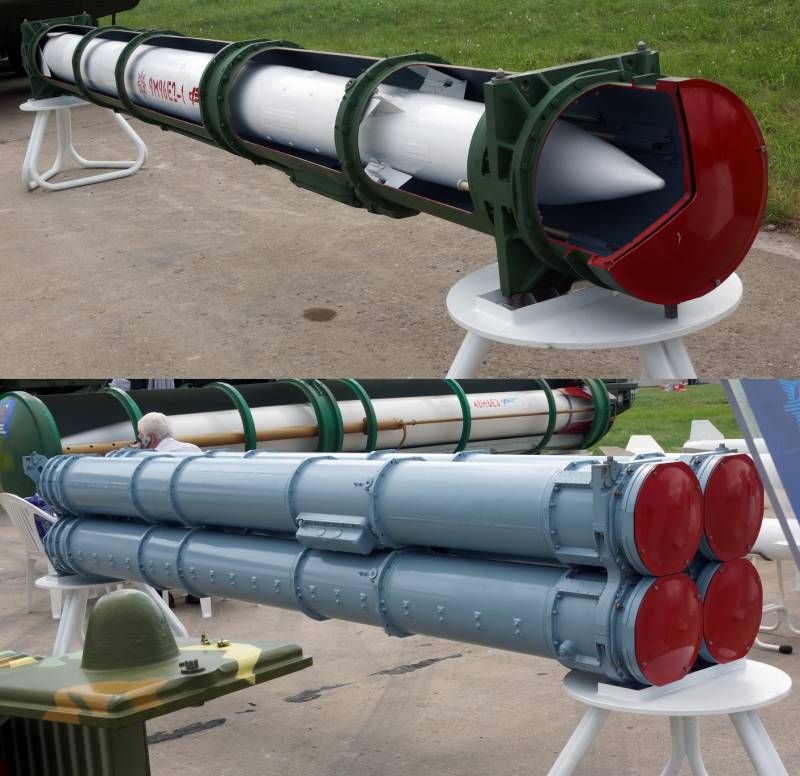
The layout of the 9M96E SAM in a transport and launch container (TPK) and the quadruple package TPK 9M100 SAM.
] Photo: bastion-karpenko.ru
SAM 9M96E2 provides target destruction at a range of up to 150 km at an altitude of its flight from 5 meters to 30 kilometers, SAM 9M100 provides target destruction at a range of up to 15 kilometers and a target flight altitude of 5 meters to 8 kilometers. These parameters overlap with a margin the characteristics of all potential targets.
The modernization of missiles will include the possibility of launching them from under the water, from periscope depth. To increase the probability of hitting the target, the transmission of commands to the missile defense system via fiber-optic cable can be implemented until the moment it leaves the water and the target is captured by the seeker. Four 9M96E, 9M96E2 missiles with ARLGSN or 9M100 IKGSN short-range missiles can fit into one vertical launch unit (UVP) of a multipurpose submarine (MCSAPL). The length of the 9M100 SAM cassette makes it possible to place it in the UVP in "two floors", if it is technically possible to realize the possibility of ejecting an empty upper cassette after firing the ammunition.
Proceeding from this, replacing four anti-ship missiles in the mines of project 885M MCSAPLs with cassettes with missiles, we will receive ammunition in an amount, for example, 8 9M96E / 9M96E2 missiles and 8/16 9M100 missiles. To attack an aircraft or an PLO helicopter, a combined launch of two 9M96E / 9M96E2 missiles and two 9M100 missiles can be used, which minimizes the target's chances of survival. This will make it possible with a high probability to ensure the destruction of four PLO aircraft / helicopters. According to the test results, the consumption of ammunition for one target can be reduced. On the other hand, depending on the problem being solved, the ammunition load of the SAMs on the SSNS can be increased.
Consequences and tactics
How can air defense systems be used on submarines? And what are the consequences of his appearance?
The appearance of air defense systems on submarines will change the situation at sea by the mere fact of its existence. For example, if information appears that Russian SSNS and SSBNs are equipped with air defense missile systems, their tests have been carried out and training air targets have been successfully hit, the United States cannot but respond, since their most effective ASW forces will be threatened.
This will require a change in tactics, equipping PLO aircraft and helicopters with active and passive countermeasures, and the development of specialized PLO UAVs. Changing the payload of PLO aircraft in favor of self-defense systems will lead to a decrease in their ammunition and / or hydroacoustic buoys, and PLO UAVs are likely to be less effective than manned vehicles.
In addition, as mentioned above, the specificity of anti-submarine warfare will not allow such UAVs to be made cheap. Because they will have to carry expensive search equipment, as well as massive weapons and sonar buoys.
In any case, the effectiveness of enemy ASW aircraft will be reduced. At the same time, since the enemy cannot know the exact composition of the ammunition load of the SSNS and SSBNs on duty, in fact, there may not be any missiles on board at all. But this virtually absent air defense system will still have an impact on ASW aviation by the potential of its presence, reducing the efficiency of its work.
There is another factor.
With increasing depth, the probability of submarine detection by acoustic methods increases due to the compression of the hull, and especially with the help of low-frequency hydroacoustic stations (GAS). This can lead to the fact that submarines will predominantly operate in the near-surface water layer.
However, another threat arises here - the improvement of non-acoustic methods for detecting submarines - by the field of the submarine track, using magnetometric sensors, laser scanners. The carriers of the aforementioned non-acoustic detection means are predominantly ASW aviation.
Without taking radical measures - reducing the size, changing the shape of the submarine body, using new materials and active camouflage means, it will not be possible to solve the problem of detecting submarines.
However, having armed the submarine air defense missile system, we will give it the opportunity to actively counter the detection of the enemy by destroying it. If earlier and now submarines can only oppose submarines and NKs of the enemy, then the integration of air defense missile systems into their armament will make it possible to resist anti-submarine aircraft as well.
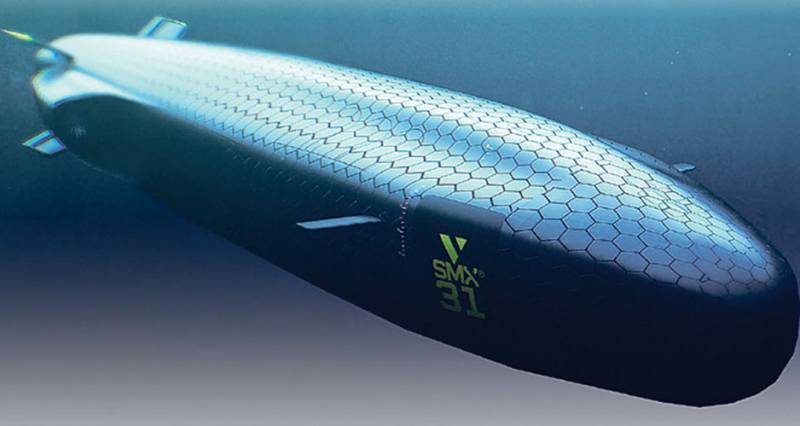
Promising submarines based on the latest concepts and technical solutions will be able to regain their stealth.
When they talk about air defense systems on submarines, they often object that the use of air defense systems will immediately unmask the submarine, the enemy will send additional forces to the area, after which the submarine will be detected and destroyed.
But who makes it necessary to use the air defense system?
The use of air defense systems is not an obligation, it is an opportunity.
As we said above, the very likelihood of the presence of an air defense system on a submarine will reduce the effectiveness of an anti-submarine aircraft. And then, let the submarine commander decide on the use of the air defense system, based on the tactical situation.
If the submarine has already been detected, torpedo armament has been opened on it, and it was possible to fight off the first strike, then why not shoot down the submarine? He will not deliver the second blow.
But you can not knock him down and make an attempt to leave, as it is done now. With the difference that now there is no other choice.
Or maybe a decision will be made to shoot down the PLO aircraft immediately after the hydroacoustic buoys began to fall into the water and the fact of active illumination was discovered - then the first attack may not take place.
Will they send two more PLO aircraft to replace the downed one?
If they are based 400-500 kilometers from the battle area, then this is about 30-40 minutes of flight at maximum speed. And then they again have to start searching for the submarine, which during this time will go 15-25 kilometers in an unknown direction.
But what if the submarine moves towards the approaching PLO aircraft (based on their intended route) and attacks first?
What if this is the goal - the organization of an ambush on the PLO aircraft?
Or is the goal - to divert ASW aviation from another area, where other submarines will strike at other targets?
Thus, the presence of an air defense system on a submarine can significantly expand the number of tactical scenarios that can be implemented by the commander of the submarine and the navy as a whole.
The US Navy has about a hundred newest Poseidons. Even if we consider that they patrol around the clock, in turn, it turns out that at any given moment half of them will be involved - about 50 cars. Divide them between fleets and areas of responsibility, and it turns out that, in fact, the United States does not have so many modern ASW aircraft.
The appearance of air defense systems on Russian submarines in the event of a military conflict can significantly reduce the number of anti-submarine aircraft at the enemy.
This, in turn, will lead to a decrease in the likelihood of destruction of domestic submarines and an increase in the effectiveness of their actions.
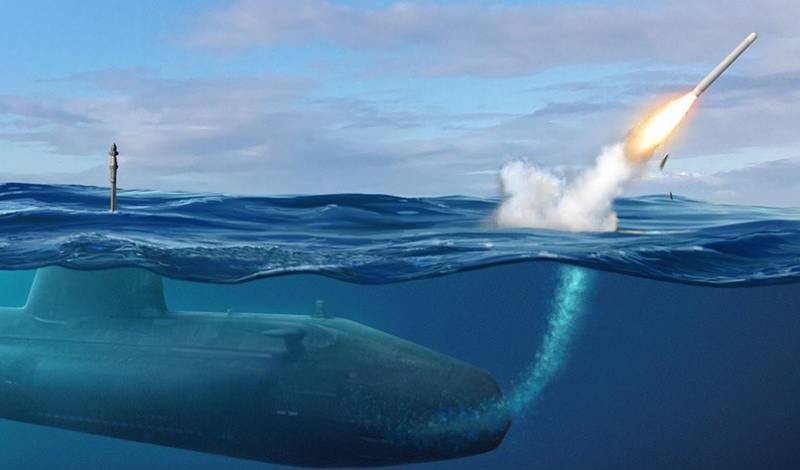
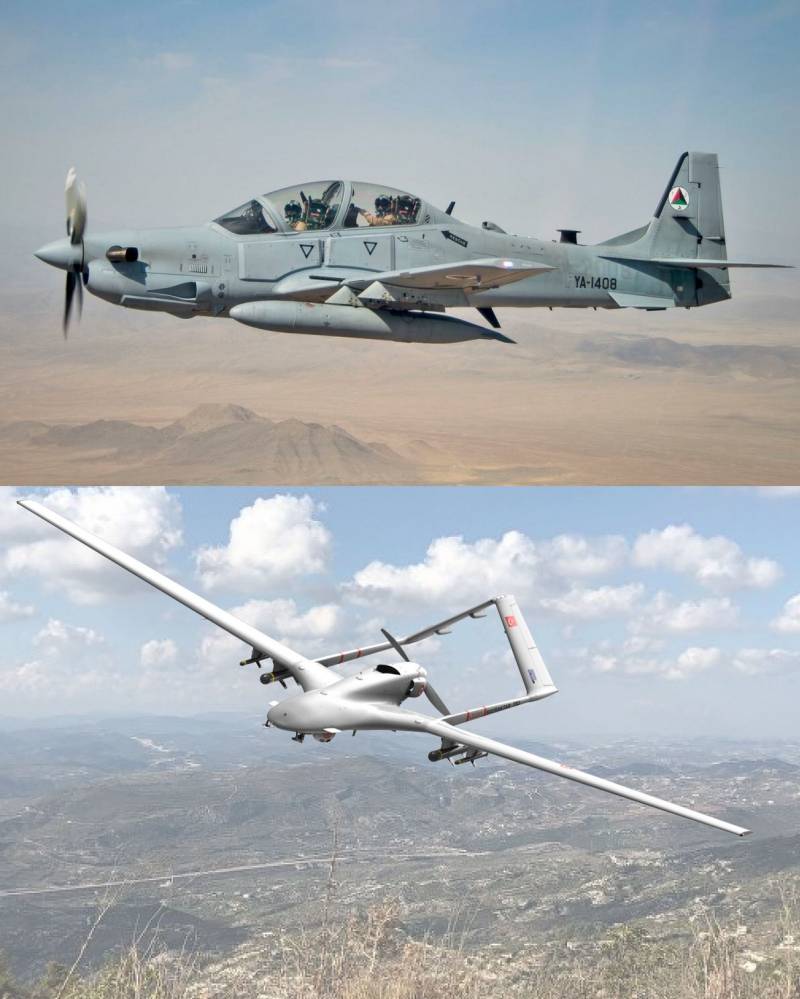
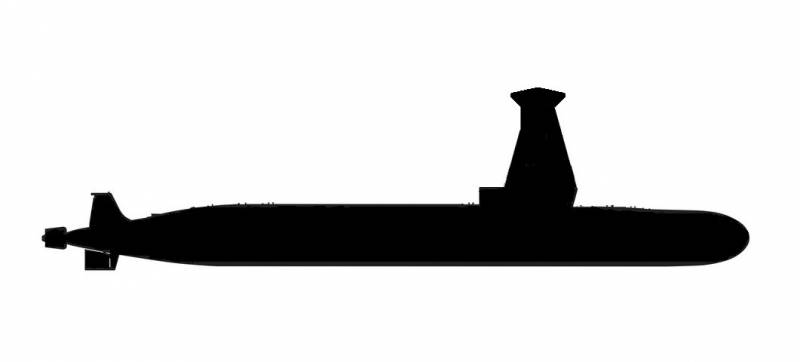
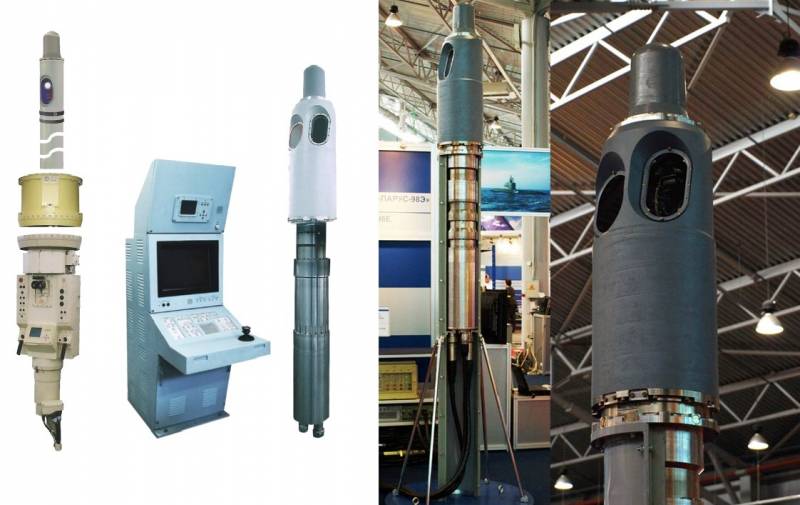
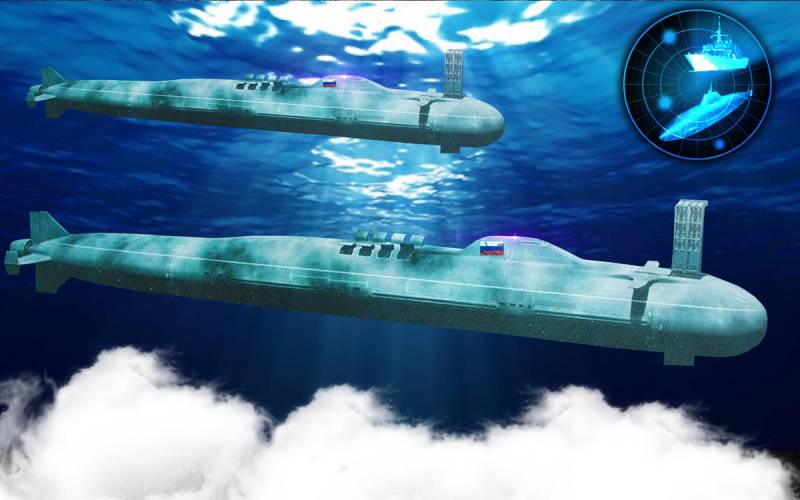
Information